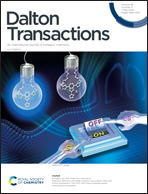Synthesis, characterization and biological activity of bromido[3-ethyl-4-aryl-5-(2-methoxypyridin-5-yl)-1-propyl-1,3-dihydro-2H-imidazol-2-ylidene]gold(i) complexes†
Abstract
Bromido[3-ethyl-4-aryl-5-(2-methoxypyridin-5-yl)-1-propyl-1,3-dihydro-2H-imidazol-2-ylidene]gold(I) complexes (8a–h) with methoxy, methyl and fluorine substituents at different positions of the 4-aryl ring were synthesized and characterized. The relevance of the 2-methoxypyridin-5-yl residue and the substituents at the 4-aryl ring with regard to the activity against a series of cell lines was determined. Particularly against the Cisplatin-resistant ovarian cancer cell line A2780cis, the most active bromido[3-ethyl-4-(4-methoxyphenyl)-5-(2-methoxypyridin-5-yl)-1-propyl-1,3-dihydro-2H-imidazol-2-ylidene]gold(I) complex 8c was more active than Auranofin. It also inhibited thioredoxin reductase more effectively and induced high amounts of reactive oxygen species in A2780cis cells. Furthermore, its influence on non-cancerous SV 80 lung fibroblasts was lower than that of Auranofin. This fact, together with a high accumulation rate in tumor cells, determined on the example of MCF-7 cells, makes this complex an interesting candidate for further extensive studies.
![Graphical abstract: Synthesis, characterization and biological activity of bromido[3-ethyl-4-aryl-5-(2-methoxypyridin-5-yl)-1-propyl-1,3-dihydro-2H-imidazol-2-ylidene]gold(i) complexes](/en/Image/Get?imageInfo.ImageType=GA&imageInfo.ImageIdentifier.ManuscriptID=C9DT04824C&imageInfo.ImageIdentifier.Year=2020)


 Please wait while we load your content...
Please wait while we load your content...